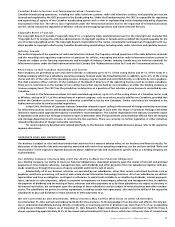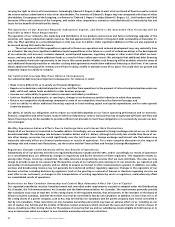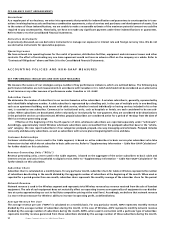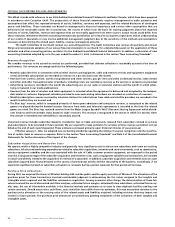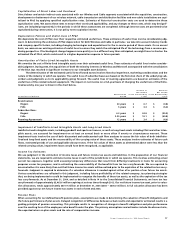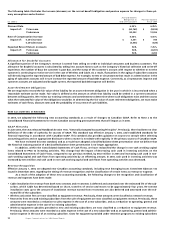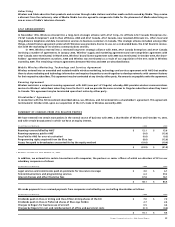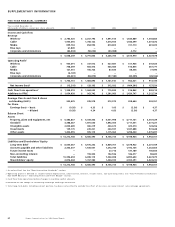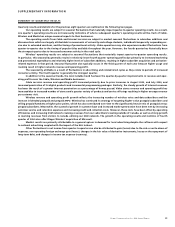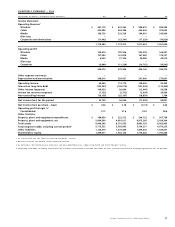Rogers 2004 Annual Report Download - page 59
Download and view the complete annual report
Please find page 59 of the 2004 Rogers annual report below. You can navigate through the pages in the report by either clicking on the pages listed below, or by using the keyword search tool below to find specific information within the annual report.
57
Rogers Communications Inc. 2004 Annual Report
Capitalization of Direct Labor and Overhead
Direct labour and certain indirect costs associated with our Wireless and Cable segments associated with the acquisition, construction,
development or betterment of our wireless network, cable transmission and distribution facilities and new cable installations are capi-
talized to PP&E by applying specified capitalization rates. Estimates of historical construction costs are used to determine these
capitalization rates. We assess these rates to ensure their continued applicability, and any changes to these rates, which may be signif-
icant, are included prospectively in the periods in which these assessments are completed. Although interest costs are permitted to be
capitalized during construction, it is our policy not to capitalize interest.
Depreciation Policies and Useful Lives of PP&E
We depreciate the cost of PP&E over their respective estimated useful lives. These estimates of useful lives involve considerable judg-
ment. In determining the estimates of PP&E depreciation for both Wireless and Cable in particular, we take into account industry trends
and company-specific factors, including changing technologies and expectations for the in-service period of these assets. On an annual
basis, we reassess our existing estimates of useful lives to ensure they match the anticipated life of the technology from a revenue-pro-
ducing perspective. If technological change happens more quickly or in a different way than anticipated, we might have to shorten the
estimated life of PP&E, which could result in a higher depreciation expense in future periods.
Amortization of Finite-Lived Intangible Assets
We amortize the cost of finite-lived intangible assets over their estimated useful lives. These estimates of useful lives involve consider-
able judgment. During 2004, the acquisitions of both the minority interests in Wireless and Microcell accompanied with the consolidation
of the Blue Jays resulted in significant increases to our intangible asset balances.
The determination of the estimated useful lives of brand names involves historical experience, marketing considerations and the
nature of the industry in which we operate. The useful lives of subscriber bases are based on the historical churn of the underlying sub-
scribers and judgments as to its applicability going forward. The useful lives of roaming agreements are based on estimates of the
useful lives of the related network equipment. The impact on net income on a full-year basis of changing the useful lives of the finite-
lived assets by one year is shown in the chart below.
Increase in Decrease
Net Income Net Income
Amortization if Life Increased by if Life Decreased by
(In millions of dollars) Period 1 year 1 year
Brand names:
Rogers 20 years $ 0.7 $ (0.8)
Fido 5 years $ 3.3 $ (5.0)
Subscriber Base:
Rogers 4.3 years $ 34.8 $ (55.9)
Fido 2.25 years $ 19.1 $ (49.8)
Roaming Agreements 12 years $ 3.4 $ (4.0)
Impairment of Indefinite-Lived Intangible Assets and Long-Lived Assets
Indefinite-lived intangible assets, including goodwill and spectrum licences, as well as long-lived assets including PP&E and other intan-
gible assets, are assessed for impairment on at least an annual basis or more often if events or circumstances warrant. These
impairment tests involve the use of both discounted and undiscounted cash flow analyses to assess the fair value of both indefinite-
lived and long-lived assets and the recoverability of the carrying value of these assets. These analyses involve estimates of future cash
flows, estimated periods of use and applicable discount rates. If the fair values of these assets as determined above were less than the
related carrying values, impairment losses would have been recognized, as applicable.
Income Tax Estimates
We use judgment in the estimation of income taxes and future income tax assets and liabilities. In the preparation of our financial
statements, we are required to estimate income taxes in each of the jurisdictions in which we operate. This involves estimating actual
current tax exposure, together with assessing temporary differences that result from differing treatments in items for accounting
purposes versus tax purposes, and in estimating the recoverability of the benefits from tax loss carryforwards. We are required to
assess whether it is more likely than not that future income tax assets will be realized prior to the expiration of the related tax loss carry-
forwards. Judgment is required to determine if a valuation allowance is needed against either all or portion of our future tax assets.
Various considerations are reflected in this judgment, including future profitability of the related company, tax planning strategies
that, are being implemented or could be implemented to recognize the benefits of these tax assets, as well as the expiration of the tax
loss carryforwards. As at December 31, 2004, and as detailed in Note 14 to the Consolidated Financial Statements, we have tax loss
carryforwards of approximately $3,463.6 million expiring at various times through 2012. Our net future income tax asset, prior to valua-
tion allowances, totals approximately $601.9 million at December 31, 2004 (2003 – $606.0 million). A full valuation allowance has been
provided against our net future income tax assets in each of 2004 and 2003.
Pension Plans
When accounting for our defined benefit pension plans, assumptions are made in determining the valuation of benefit obligations and
the future performance of plan assets. Delayed recognition of differences between actual results and expected or estimated results is a
guiding principle of pension accounting. This principle results in recognition of changes in benefit obligations and plan performance
over the working lives of the employees who benefit under the plan. The primary assumptions and estimates include the discount rate,
the expected return on plan assets and the rate of compensation increase.






